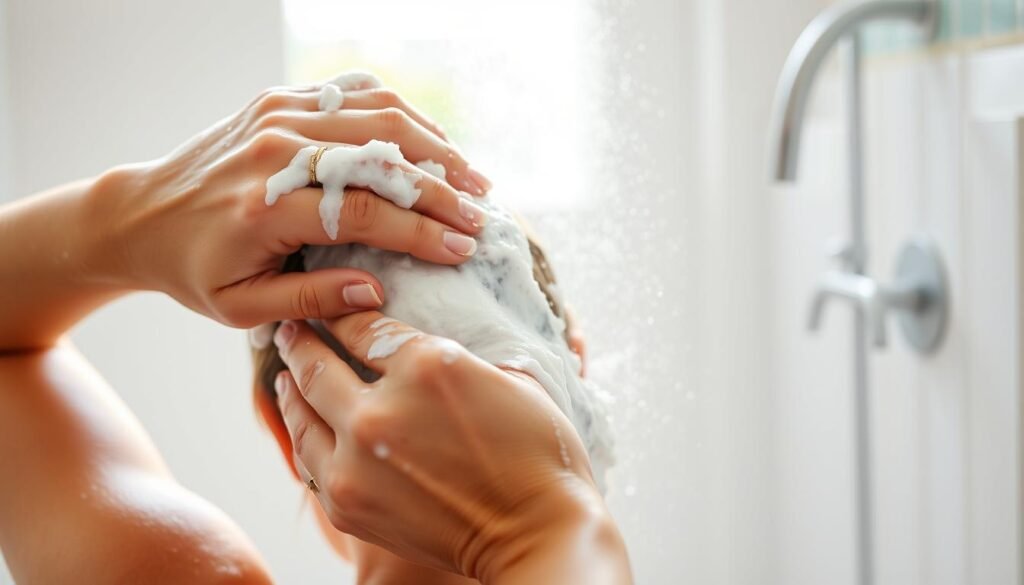Did you know nearly half of all adults struggle with dandruff at some point? This condition can hurt how we feel about our looks. It even impacts our self-esteem and comfort. Because of this, it’s key to keep our scalp healthy by regularly using shampoo. This step helps control those annoying flakes. It boosts our overall well-being too.
By picking a good anti-dandruff shampoo, people can fight off flaky skin. This also reduces irritation. What’s more, we face daily challenges like pollution and product buildup. These make it very important to clean our scalp well. We need to wash away extra oil and dead skin cells. Choosing the right shampoo makes a big difference. It improves our hair and scalp’s look and health.
Key Takeaways
- Dandruff affects nearly 50% of adults, impacting both comfort and confidence.
- Regular shampooing is vital in managing dandruff and enhancing scalp health.
- Effective anti-dandruff shampoos can alleviate itching and flaking.
- Incorporating lifestyle changes can further help in controlling dandruff.
- Different active ingredients in dandruff shampoos cater to varying needs.
Understanding Dandruff and Its Causes
About half of all adults worldwide have dandruff. It’s a common issue that needs understanding for proper control. The main cause is a fast skin cell turnover. This creates dead skin flakes on the scalp. Several factors might make this situation worse.
The Role of Skin Cell Turnover
Skin cell renewal keeps the scalp healthy. But, if it speeds up, more skin cells shed. This leads to the flakes we see as dandruff. Men often get dandruff more than women. This is due to more oil production, especially during teenage years.
Factors Contributing to Dandruff
Various dandruff causes help us understand how to prevent and treat it. Seborrheic dermatitis and scalp psoriasis are examples. Environmental elements like cold weather and stress also play a part. People with oily hair or certain illnesses like Parkinson’s disease and HIV are more at risk.
Symptoms include itchiness, oily flakes, and irritated patches on the scalp and face. Keeping your scalp clean through regular washing is key. For tips on keeping your scalp clean, check out this resource.
Signs of Dandruff To Look For
Knowing the signs of dandruff is the first step to manage it. You might see flakes or dry spots on your scalp and shoulders. These signs mean you have flaky skin. Recognizing them helps you choose the right treatments to keep your scalp healthy.
Identifying Flaky Skin
Flaky skin is a common sign of dandruff. People with dandruff often find small, white or yellowish flakes in their hair or beard. These flakes can appear more or less, depending on the season and how stressed you are. Spotting them early is important for treatment.
Scalp Itchiness and Discomfort
Itchy scalp is another key symptom of dandruff. It feels like you always have to scratch your head. This can come with redness and irritation, making things worse. If you notice this itchiness, act fast to reduce dandruff’s effects on your life.
The Importance of Regular Shampooing
Washing your hair often is key for a healthy scalp. It removes oil, dirt, and dead skin, which can cause dandruff. Daily hair washing keeps the scalp balanced. It stops fungi and bacteria from growing. Clean hair means a dandruff-free head.
Daily Cleansing for Scalp Health
Research shows washing your hair daily is good for scalp health. People who shampooed 5 to 6 times a week felt better about their hair and scalp. In studies, 68% of young people and 79% of adults washed their hair daily. This helps keep the scalp clear and prevents itching.
Reducing Oil and Dead Skin Buildup
Dandruff gets worse with oil and dead skin. If you have oily hair, washing it often is advised. This cuts down on oil and keeps the scalp clean. A study found washing your hair daily is best. It keeps hair quality high and the scalp healthy.
What is Regular Shampooing for Dandruff?
Regular shampooing for dandruff is key for a healthy scalp. It uses special shampoos to fight flakes. These shampoos have ketoconazole, zinc pyrithione, and selenium sulfide. They tackle dandruff’s causes and invigorate the scalp.
To beat dandruff, a steady routine is crucial. Experts say to use dandruff shampoo two to three times weekly. Use regular shampoo on other days. Sometimes, switching dandruff shampoos can help, as their effectiveness may decrease over time.
There are many products for different needs. For tough symptoms, Head & Shoulders Clinical Strength Dandruff Defense Shampoo with 1% selenium sulfide works well. For daily use, Neutrogena T/Sal Therapeutic Shampoo has 3% salicylic acid. Knowing your options helps in managing dandruff effectively.
Even after successful treatment, stay alert. Dandruff can return, so you may need to restart treatments. If there’s no improvement after several weeks, see a dermatologist or healthcare provider.

Good dandruff treatment boosts hair health and cuts down on flaky skin. This boosts confidence. By keeping up with regular shampooing for dandruff, you keep your scalp healthy and lessen flake recurrence.
Choosing the Right Anti-Dandruff Shampoo
Finding the perfect anti-dandruff shampoo is crucial for handling this widespread issue. Millions around the globe are impacted. Knowing about key ingredients and the different shampoos can lead to better scalp health.
Key Ingredients to Look For
When choosing anti-dandruff shampoo, it’s vital to know the active ingredients. Notable ones include zinc pyrithione, salicylic acid, ketoconazole, selenium sulfide, and coal tar. Each one fights dandruff in its way:
- Zinc Pyrithione: Known for fighting fungus.
- Ketoconazole: Great for fungal problems.
- Selenium Sulfide: Reduces flaking and itch.
- Salicylic Acid: Helps peel off dead skin.
- Coal Tar: Slows skin cell growth.
Understanding Different Types of Anti-Dandruff Shampoos
Choosing the right anti-dandruff shampoo also means knowing the types available. Tar-based options are great for severe dandruff. There are special versions for conditions like seborrheic dermatitis or eczema too. Picking a shampoo that suits your scalp will improve results. Using these shampoos 2-3 times weekly is advised to avoid dryness. If you still struggle, seeing a dermatologist is a smart move.
Steps for Effective Shampoo Application
To get the best results from shampooing, you need to prepare and have good technique. By doing certain steps when washing, you can make your hair care routine better.
Prepping the Hair Before Shampooing
Starting with prepping hair the right way is key. First, gently comb your hair to remove tangles and knots. This makes shampooing smoother. Before putting on shampoo, slightly wet your hair with warm water. Warm water makes the cuticles open so the shampoo can go deep into your hair.
Techniques for Lathering and Rinsing
When you put on shampoo, you should lather it twice. The first time cleans your scalp. The second time, make sure it gets all through your hair. Let the shampoo sit for about five minutes so it works well. Then, rinse with cool water. This makes your hair cuticles close, makes your hair shiny, and washes away all leftovers. Getting good at these lathering techniques can really make your hair look and feel great.

Avoiding Common Shampooing Mistakes
Effective shampooing is key in controlling dandruff. Avoiding shampooing mistakes can greatly help with anti-dandruff treatments. One big mistake is not wetting hair completely before shampooing. If you apply shampoo to dry hair, it won’t lather well or work as it should.
Not rinsing thoroughly is another mistake. This can leave harmful residues that worsen scalp problems. Also, using hot water is a mistake because it can take away natural oils, causing dryness and irritation. Lukewarm water is best for shampooing and keeps the scalp healthy.
How you lather matters too. Scrubbing your scalp too hard can increase irritation. It’s better to massage the scalp gently to spread the shampoo evenly. A scalp brush can also help get rid of dead skin and buildup, making dandruff treatments more effective.
Regular shampoos with sulfates, parabens, and phthalates may cause allergic reactions and make dandruff worse. Look for ingredients like zinc pyrithione, which treats dandruff with less irritation. Also, being consistent with shampooing is important. Missing applications can slow down the progress. Knowing and avoiding these mistakes can lead to a better anti-dandruff routine.
| Common Shampooing Mistake | Impact on Dandruff Treatment |
|---|---|
| Not wetting hair before use | Prevents proper lathering; reduces effectiveness |
| Skipping rinse | Leaves residues; may worsen scalp irritation |
| Using hot water | Strips away natural oils; increases dryness |
| Aggressive scrubbing | Can cause increased irritation; ineffective treatment |
| Use of harmful ingredients | Exacerbates dandruff; may lead to allergic reactions |
Integrating Anti-Dandruff Shampoo into a Hair Care Routine
Adding an anti-dandruff shampoo to your hair care routine takes planning. It depends on your hair and scalp. The right use frequency varies for everyone.
Frequency and Timing of Use
Start by using the anti-dandruff shampoo every day if dandruff is a big problem. As your scalp gets better, you might use it just two or three times a week. Remember, seeing results can take a few weeks. Keep using the Anti-Dandruff Shampoo regularly for the best outcome.
Pairing with Conditioners for Optimal Results
After shampooing, a good conditioner can make a big difference. It adds moisture and fights the dryness some medicated shampoos cause. Pick a conditioner that works well with your anti-dandruff shampoo. For example, combine Head & Shoulders Tea Tree Oil Anti-Dandruff Shampoo with a hydrating conditioner. This helps keep your scalp healthy and free from flakes. Learn more about this approach by checking out this helpful article here.
Complementary Dandruff Prevention Tips
Searching for ways to stop dandruff is smart. Using shampoos and adding Managing Stress and Healthy Diet tips helps. These steps improve the scalp’s health.
Managing Stress for Scalp Health
Stress links to skin issues like dandruff. Controlling stress benefits the skin. Mindfulness, meditation, and exercise make you relax. Daily use of these practices fights stress effects on the scalp.
The Importance of a Healthy Diet
Diet is key in fighting dandruff. Eating foods with zinc and omega-3s is vital. Nuts, fatty fish, and leafy greens boost hydration and control oil.
Eating fruits reduces inflammation. This tackles dandruff in a complete way.
Natural Dandruff Remedies to Consider
Looking into Natural Dandruff Remedies can be a whole-body approach to scalp care. They use natural ingredients, which could help those with dandruff. Tea tree oil is notable for its ability to fight the fungus Malassezia globosa, often behind dandruff.
Using Tea Tree Oil and Other Natural Ingredients
Tea tree oil works well for dandruff, dealing with both flakes and itchiness. A mix of tea tree oil with a carrier oil, such as coconut oil, is good for the scalp. Aloe vera and apple cider vinegar are also good, thanks to their hydrating and balancing effects.
Adding neem, lemon, and fenugreek seeds to your routine could help too. Apple cider vinegar, diluted and applied post-shampoo, cleans scalp buildup. Eating foods rich in omega-3 like salmon and walnuts improves scalp health.
Hydration and Its Impact on Scalp Health
Staying hydrated is key for a healthy scalp. Not drinking enough water can worsen dandruff by causing more dryness and irritation. Hydration keeps the scalp moist, helping to soothe symptoms. Drink plenty of water and use products that hydrate the scalp.
A mix of staying hydrated and using Natural Dandruff Remedies promotes a healthy scalp. These natural remedies should be part of a wider hair care plan. If issues remain, see a healthcare expert. More info on treatments is available here.

Conclusion
Washing your hair often is key in dealing with dandruff. This affects about half of everyone worldwide. It shows men might get it more, but dandruff can bother anyone. It leads to flakes, itchy head, and feeling uncomfortable.
To fight dandruff, picking the right shampoo matters a lot. Products with selenium sulfide and salicylic acid are great. They tackle the fungus causing dandruff. Also, changing your treatment based on your symptoms is crucial. Don’t forget to talk to a skin expert when you need to.
Keeping a good balance is essential for dandruff care. A routine that involves regular washing and taking care of your hair works best. This helps keep your hair and scalp healthy. Following these steps carefully can mean much better dandruff control over time.